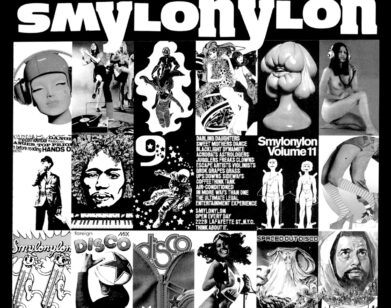Porochista Khakpour’s Flight Risks
We’re sitting in Harlem Shake, a newish burger restaurant near Marcus Garvey Park with Sam Cooke playing over the speakers, and Porochista Khakpour has purple hair. That wouldn’t be such a big deal—but she’s been memorialized as a blonde in a recent issue of Elle, in which she had her photo shot in connection with iconic blondes of the past. But a lot’s changing for Khakpour these days. There’s her new novel, The Last Illusion, the story of Zal, a feral child looking for belonging in New York, and Silber, an arrogant magician whose “last illusion” will be making the World Trade Center disappear. There’s her ongoing battle with late-stage Lyme disease—she says she’s not supposed to eat burgers but that she feels awful all the time anyways, so why not— recurrent now after a few years dormant. And there’s her apartment, still without gas after the months-ago Harlem gas explosion. We sat down to discuss artist’s residencies, fear of flying, and online bikini shopping.
MICHAEL HAFFORD: There are, to me, two through-lines in The Last Illusion—the line following Zal and his struggles as a feral child to adjust and the line following Silber and the intersection of his illusion with 9/11. Which of those did you hit on first, or were they simultaneous?
POROCHISTA KHAKPOUR: They were two separate things that were in my head around the same time. Here’s the genesis of the novel. I was at a writing residency—one of my first—this is shortly after my first book had come out. I suddenly felt like I couldn’t write at all. I was really, really nervous about a second novel. I decided I didn’t want to write, and yet I was at this residency because I had applied to it way before. I brought with me a bunch of books. We had access to a local library, and I could get more books there. I decided I would read during my whole residency. Do no writing and just read. One of the books I grabbed was a Dick Davis translation of the Shahnameh, the Persian Book of Kings, and I just brought that along as a sort of comforting thing because I had grown up with my father reading stories out of that. I always really fixated on this one story of Zal that this book is based on. While I was at the residency, I would take these smoking breaks. I was friends with this one other resident. We were the rebels of the residency. Everyone else would sit around and talk about how much work they were doing and how amazed they were by all their great work. We would just be like, “We’re not doing anything.” At one point, even, into the second week where I was just reading and doing no writing, I was going online and buying bikinis over and over for a trip to Mexico in a few months. All I wanted to do was tell people, “Yeah, I’m spending my writing residency time buying bikinis, fuck you.” I was going crazy at this residency.
We were on a smoking break and this resident said to me. She was going on her usual monologue about stuff, smoking, and she said, “Whatever you do, don’t Google ‘feral children.'” That sentence kind of stuck with me. I was like, “What are you talking about?” And she said, “Just don’t do it, never mind.” For whatever reason, that night, I did, of course, Google feral children. It was horrifying. Really interesting. But then I had this book—The Persian Book of Kings—there, and the Zal story was something I fixated on my whole childhood. Naturally, those two elements came together, and I imagined him as a feral child; a boy that was raised as a bird. Around the same time, just before I went to the residency, almost out of nowhere I had had this idea about a magician whose final illusion was going to be the disappearance of the World Trade Center. That also came from my childhood fixation on David Copperfield—the Statue of Liberty. That was in ’83, and it aired as a telecast when I was about five. It never, ever got out of my brain. Even then, I thought, “There’s symbolism in this.” I was a new American, I was just learning English, and I thought, “There’s something really symbolically rich about trying to vanish the Statue of Liberty.” It just haunted me forever.
That summer, I had planned three residencies in a row—all summer I was going to be gone—by the end of that summer, by the time I got to Yaddo [a residency in Saratoga Springs, New York] I had this idea of trying to intertwine these things. To me, the sort of binding agent between the two was my own PTSD from 9/11. At this point, it was in my first novel, it was in all the essay work I was doing. I had never really moved past 9/11. For me, that was what kind of brought David Copperfield with this feral boy of my childhood. I experimented with the first draft and after I had the first draft I got to see what this book was about. I had to analyze myself. I realized, at its core, was an outsider narrative, an outsider story and a story in some ways about storytelling. All of that, too, was something I discovered after this weird first draft that artificially melded these two separate stories.
HAFFORD: The other thing that comes up again and again is this notion of flight and of arrested flight. Zal, the bird boy, can’t fly —nor does he want to. Asyia’s father works for Boeing and her obese sister Willa has a later incident with a window. Is that something that you unearthed in your analysis of your first draft or is that something you developed intentionally?
KHAKPOUR: It was something that came very soon. It kind of had to do with me observing my own themes and symbols. It happened after the first novel—it had a lot of avian imagery—and had a lot of, of course, 9/11 stuff. In some ways, I see these books as quite similar. The first book, for me, was much more obviously autobiographical but this book also has strong autobiographical elements. They’re both structured very similarly and they have similar outsider narratives. The point of the bird stuff for me has always been a sort of personal trauma. My first memory of the Iran-Iraq War as a child was of anti-aircraft missiles in the air. When we got to the U.S. I was always really scared of even hot air balloons—I would have panic attacks—and then I was in an emergency landing right before 9/11 and then 9/11 happened. I watched it outside my window. I’ve had all these traumas that have related to the sky, weirdly. I kind of followed the fear in this book and let the symbolism explicitly take the weight of those things. I was also thinking a lot about Latin American writers I loved, and American experimental writers I loved, too. I was thinking about how they would play with symbolism in a different way, almost overtly, almost dare the reader to look at the symbols and the thematics. They would fuck with you in that way, too. I wanted to create a really unique texture to this book where you had to think about symbols in a totally different way by putting them in plain sight.
HAFFORD: I felt that knowing what I know about you, I saw a lot of autobiography. Especially in the character of Hendricks’s wife. She’s your same age, also teaches writing at Columbia, also has black eyes, is also Iranian-American. She dies off-screen before the book begins. Is that your way of killing the author? Moving yourself out of the way of the story?
KHAKPOUR: [laughs] In some ways, yeah. Almost everybody that knows me sees me in a different character in this book.
HAFFORD: Just by the facts of the biography.
KHAKPOUR: That one, for sure. I have a secret paragraph tucked in there about all the women Silber is supposedly dating, I had them all be versions of me. Just one paragraph, I gestured towards that. I don’t know if I’m trying to be all Cindy Sherman about it, putting myself in there. When I started writing the second book I said, “I have to unlearn everything I learned about the publishing experience of the first book and just really write the book I want to read.” That Toni Morrison quote that I always bastardize. I never wanted to write a long memoir about my life, but I was interested in using fabulism to tell different parts of my own story. That’s the truth. The other interesting thing is that as I was writing it, everything was animated. My first book, I saw it as a movie with my actor versions of these people. With this book, I saw it all as a combination between anime and Marvel and DC Comics. I wish I could draw that, so I could create it. You know that movie Spirited Away by Hayao Miyazaki? I saw something between his style and literally—I guess more like Marvel style. Once I had that in my head, it was somehow easier to write about aspects of my own life through this almost graphic novel depiction in my head.
POROCHISTA KHAKPOUR’S THE LAST ILLUSION IS OUT NOW VIA BLOOMSBURY. SHE WILL HAVE A BOOK LAUNCH EVENT TOMORROW EVENING AT POWERHOUSE ARENA.







